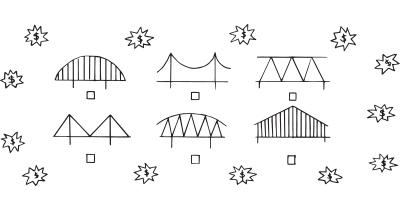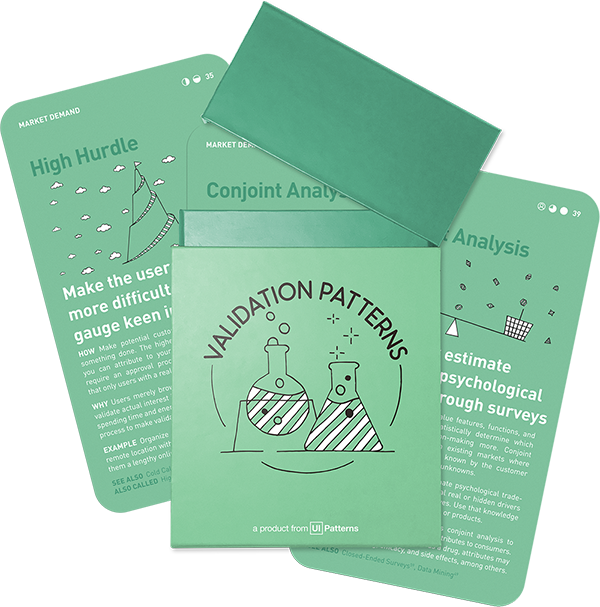Also called: Landing Page Validation
See also: Dry Wallet, Feature Stub, Run Test Ads
Difficulty: Easy
Evidence strength
Relevant metrics: Unique views, Time spent on page, Call to action clicks, Email Sign ups
Validates: Desirability
How: Sell your future product through several landing pages with fake 'Buy' buttons. Drive traffic to your landing pages through ads or similar methods and learn how many click your ads and continue to click your fake button.
Why: Advertising your product (or several versions of it) as if it was real, you will gauge interest and find which version of your messaging corresponds best with user needs.
This experiment is part of the Validation Patterns printed card deck
A collection of 60 product experiments that will validate your idea in a matter of days, not months. They are regularly used by product builders at companies like Google, Facebook, Dropbox, and Amazon.
Get your deck!Before the experiment
The first thing to do when planning any kind of test or experiment, is to figure out what you want to test. To make critical assumptions explicit, fill out an experiment sheet as you prepare your test. We created a sample sheet for you to get started. Download the Experiment Sheet.
Sell before building
The initial focus of too many entrepreneurs is too often on what product to build and what team that should be hired to build the product. After building the product, they then figure out whether they can sell what they’ve build or not.
The problem with this approach is that being able to sell the product is most often more risky than being able to build it. If were are lean entrepreneurs, we want to validate our most critical assumptions first. Those are typically around the market.
Landing pages are often misused as glorified email capture pages, but they can be used more extensively to test your future product – before you have built anything at all. Before writing a single line of code.
Instead, start by testing whether you can sell your intended product in the first place. Before you start building it. Start by explaining the unique selling points and why users should buy your product, what problem the product will help solve.
If it doesn’t work, build another landing page.
It’s better to start testing whether people would buy – or at least to get people to acknowledge and sign up for buying when your product is done.
After the experiment
To make sure you move forward, it is a good idea to systematically record your the insights you learned and what actions or decisions follow. We created a sample Learning Sheet, that will help you capture insights in the process of turning your product ideas successful. Download the Learning Sheet.
Examples
Checkmaid.com
Checkmaid.com, a market platform for cleaning maids, validated their business model without cleaners. Instead, a spoof landing page was created with a booking form and a phone number. After running test ads, they learned the conversion rate had they actually had cleaners.
Buffer
Joel Gascoigne fleshed out the first landing page for used that to gauge demand for various features and price plans rather than just to build up a mailing list.
This was as simple as adding an extra page between the features page and the signup form; the interstitial page showed a pricing table, and the visitors could select the plan that appealed to them.
These extra clicks not only showed the visitor’s interest in the product, but also gave the team real-world data on what kind of pricing would be appropriate for the market.
Related plays
- A Lean Approach To Product Validation by Jon Lay & Zsolt Kocsmárszky
- UX for lean startups by Laura Klein
- The Real Startup book - Landing Page smoke test by Tristan Kromer, et. al.

